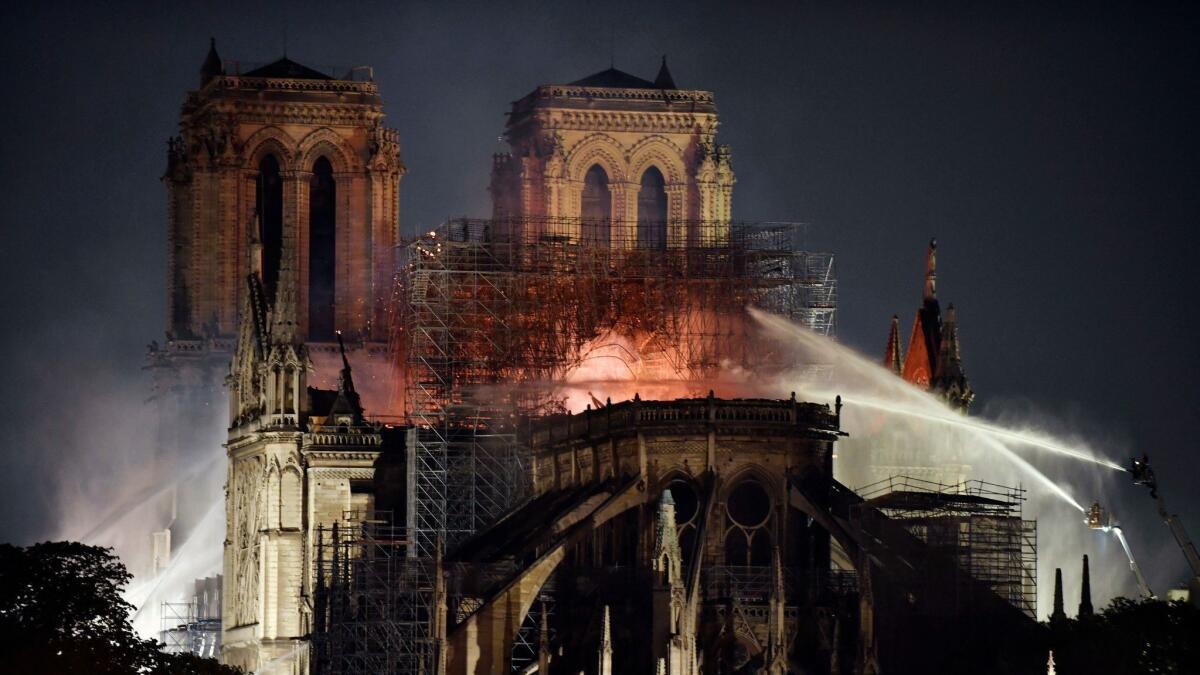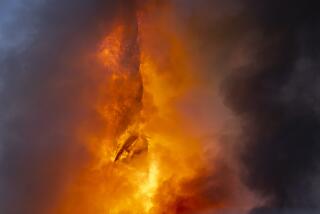Op-Ed: Notre Dame can be rebuilt, but its unique sound may be gone forever

Like so many people on Monday, I tuned in to the news of the fire in Notre Dame Cathedral in Paris. As others watched flames consume a place of devotion, a symbol of resistance through revolution or an architectural marvel, as a medieval music historian, I mourned for the unrecorded sounds that will now never be heard again.
For more than 100 years beginning in the late 12th century, some of the greatest advances in European music were entwined with the phases of construction of the cathedral. The first known pieces for three and four independent voices with rhythmic indications — the direct predecessors of all commonly sung Christian hymns and holiday carols, to say nothing of popular music today — were said to have been composed, as a 13th century author writes, for the use in “the great church of the Blessed Virgin in Paris.”
Two composers whose names survive, Master Leonin and Perotin the Great, rewrote the entire year’s liturgy to take advantage of Notre Dame’s resonant possibilities. Perotin in particular seems to have been a composer for the ages. Around the year 1198, he stretched short segments of chant into monumental works of freely floating voices above a sustained bass that, in a description by Umberto Eco, “filled the naves … and did not cease for the whole time that it took a speaker to repeat 12 ‘Ave Maria’s in a slow and cadenced voice.”
We would not know of Leonin and Perotin at all were it not for a single essay written by an unnamed source nearly a century later. Musicologists today call the writer Anonymous IV. He or she seems to have been a stranger to Paris and thus noticed details of the city’s soundscape and musical history that were too commonplace for natives to register. Anonymous IV described how the Parisians wrote down rhythm, the squabbles among clergy and what people were singing in Notre Dame. Yet the one aspect of medieval music that the writer did not capture, for there was no way to, was what music historians want most to know: What did the music actually sound like?
Anonymous IV would have needed not just the vocabulary of modern acousticians but the technologies to measure the resonances of the space in which it was performed. Maybe then we would be able to reconstruct how changes in its architecture over the nearly 200 years it took to build Notre Dame changed the sound.
We still lack the technologies to re-create the sound of historic spaces that have been transformed, or destroyed. But recent advances in recording, signal processing and artificial intelligence are bringing us closer.
The stakes for rediscovering past sounds are great. What sounds consonant or harmonious to us today was shaped by the works of these composers 800 years ago — and those pieces of music were informed by the acoustics of the space for which they were written. A space that is now lost, and whose story may be irretrievable.
Regarded alongside the ruined stained glass, the charred artworks or even the memory of countless masses, the loss of Notre Dame Cathedral as a historic musical space may seem insignificant. But the art was once photographed and might be reconstructed at least in part; the stories of baptisms and requiems might survive through retellings. But Notre Dame’s sound — a vital part of the history of music, thought to be hidden but perhaps someday to be rediscovered — may just have slipped beyond our grasp, to be lost forever.
Michael Scott Cuthbert is an associate professor of music and the faculty director of digital humanities at the Massachusetts Institute of Technology.
Enter the Fray: First takes on the news of the minute from L.A. Times Opinion »
Follow the Opinion section on Twitter @latimesopinionand Facebook
More to Read
A cure for the common opinion
Get thought-provoking perspectives with our weekly newsletter.
You may occasionally receive promotional content from the Los Angeles Times.






